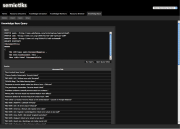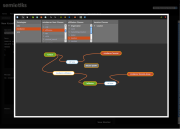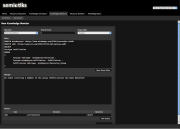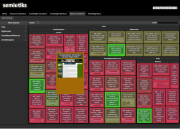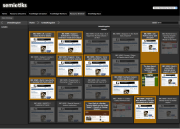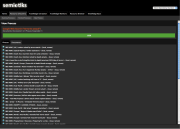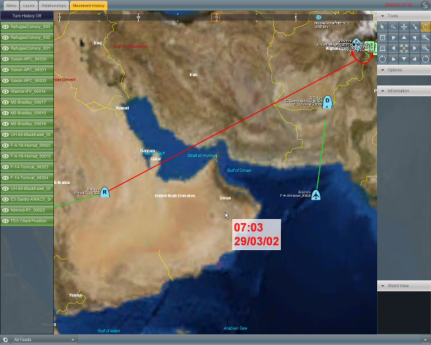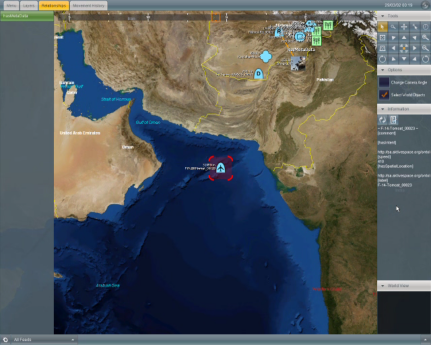Research Projects
Below are some of the projects I have worked on. More information about each of the projects can be found on the ECS project pages.
SOCIAM
 The
SOCIAM project aims to advance our understanding of a range of
socio-technical systems that go under the heading of 'social machines'.
Social machines are systems in which human agents and technological
systems work together as part of an integrated mechanism that is of
explanatory relevance to a broad range of phenomena. Common examples of
social machines include a number of Web-based systems, such as Twitter,
Wikipedia, Facebook, and Google Search. An important sub-class of social
machines — dubbed knowledge machines — are also concerned with the
realization of knowledge-relevant processes. These include systems that
are typically categorized under the headings of citizen science systems
(e.g.,
Galaxy Zoo), human
computation systems (e.g.,
reCAPTCHA), and
so-called Games-With-A-Purpose (e.g.,
Genes In Space).
The
SOCIAM project aims to advance our understanding of a range of
socio-technical systems that go under the heading of 'social machines'.
Social machines are systems in which human agents and technological
systems work together as part of an integrated mechanism that is of
explanatory relevance to a broad range of phenomena. Common examples of
social machines include a number of Web-based systems, such as Twitter,
Wikipedia, Facebook, and Google Search. An important sub-class of social
machines — dubbed knowledge machines — are also concerned with the
realization of knowledge-relevant processes. These include systems that
are typically categorized under the headings of citizen science systems
(e.g.,
Galaxy Zoo), human
computation systems (e.g.,
reCAPTCHA), and
so-called Games-With-A-Purpose (e.g.,
Genes In Space).
The SOCIAM project will run from May 2012 to May 2017. The main collaborators are the University of Southampton, the University of Edinburgh and the University of Oxford.
Virtual Vehicles
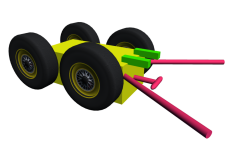 The
Virtual Vehicles project is based on the work of the Italian neuroscientist and
cyberneticist, Valentino Braitenberg. Through a series of elegant thought experiments, published in his 1984 book, Vehicles: Experiments in Synthetic Psychology, Braitenberg suggested that surprisingly complex behaviour could emerge from the interaction between forces and factors that were distributed across brain, body and world. In particular, once we factor in the contributions of the physical environment and bodily structure, the kind of behavioural control mechanisms required to yield intelligent behaviour may, Braitenberg suggested, be quite simple.
The Virtual Vehicles project is an attempt to extend Braitenberg’s original work using state-of-the-art approaches to the creation of virtual robotic platforms and interactive 3D environments.
The
Virtual Vehicles project is based on the work of the Italian neuroscientist and
cyberneticist, Valentino Braitenberg. Through a series of elegant thought experiments, published in his 1984 book, Vehicles: Experiments in Synthetic Psychology, Braitenberg suggested that surprisingly complex behaviour could emerge from the interaction between forces and factors that were distributed across brain, body and world. In particular, once we factor in the contributions of the physical environment and bodily structure, the kind of behavioural control mechanisms required to yield intelligent behaviour may, Braitenberg suggested, be quite simple.
The Virtual Vehicles project is an attempt to extend Braitenberg’s original work using state-of-the-art approaches to the creation of virtual robotic platforms and interactive 3D environments.
Virtual Vehicles uses the Unity game engine to construct a series of simple four-wheeled vehicles that are embedded in a virtual 3D environment. The behaviour of each vehicle is controlled by a library of custom Unity components that act as the vehicle’s nervous system. Vehicles can perceive their environment using visual, olfactory and tactile information. Visual information is provided by camera components that function as the vehicle’s eyes. They render the current scene (from the vehicle’s perspective) to a 2D texture asset that is then subjected to image processing. Tactile information is provided by sensors attached to hinge joints or C# routines that rely on RayCasting techniques. Motor output takes the form of physical forces that are applied to Wheel Collider components. These change the angular orientation and rotation of the vehicle’s wheels and control the vehicle’s movement in the 3D landscape.
ITA ACT-R CSSC
 The
ITA ACT-R CSSC project forms part
of the International Technology Alliance
(ITA) research programme. The ITA ACT-R CSSC project aims to develop a Cognitive Social Simulation Capability (CSSC) based on the
ACT-R cognitive architecture. Cognitive social simulation is a computer simulation technique that attempts to understand the interaction between cognitive, social and technological factors in a variety of different task contexts. This makes the technique useful for understanding situations in which multiple individuals must work together to perform a cognitive task. Some examples include a team of medical practitioners working together to diagnose an illness, a team of intelligence analysts assessing intelligence information, and a team of engineers working to design a new product. All these tasks are ones in which aspects of human cognition play an important role. However, they are also ones in which issues of social engagement and interaction are of critical importance. The
ITA ACT-R CSSC project aims to support computer simulations that emphasize the potential interactions between cognitive, social and technological factors in team-based tasks. The
ACT-R CSSC simulation capability relies on the use of the ACT-R cognitive architecture to model the capabilities and constraints of the human cognitive system in a realistic manner. This enables the simulations to accommodate mechanisms for learning, memory, attention and reasoning. In addition, the ACT-R CSSC provides support for the modelling of social processes. These allow individuals to communicate and share information, thereby influencing the activity of other team members.
The
ITA ACT-R CSSC project forms part
of the International Technology Alliance
(ITA) research programme. The ITA ACT-R CSSC project aims to develop a Cognitive Social Simulation Capability (CSSC) based on the
ACT-R cognitive architecture. Cognitive social simulation is a computer simulation technique that attempts to understand the interaction between cognitive, social and technological factors in a variety of different task contexts. This makes the technique useful for understanding situations in which multiple individuals must work together to perform a cognitive task. Some examples include a team of medical practitioners working together to diagnose an illness, a team of intelligence analysts assessing intelligence information, and a team of engineers working to design a new product. All these tasks are ones in which aspects of human cognition play an important role. However, they are also ones in which issues of social engagement and interaction are of critical importance. The
ITA ACT-R CSSC project aims to support computer simulations that emphasize the potential interactions between cognitive, social and technological factors in team-based tasks. The
ACT-R CSSC simulation capability relies on the use of the ACT-R cognitive architecture to model the capabilities and constraints of the human cognitive system in a realistic manner. This enables the simulations to accommodate mechanisms for learning, memory, attention and reasoning. In addition, the ACT-R CSSC provides support for the modelling of social processes. These allow individuals to communicate and share information, thereby influencing the activity of other team members.
The ITA ACT-R CSSC project will run from May 2013 to May 2016. The main collaborators are IBM UK, Carnegie Mellon University and Airbus.
IEXTREME
 The
IEXTREME project was a trans-Atlantic collaborative project, funded by the
U.S. Office of Naval Research.
The project was a collaborative venture between the University of Southampton,
Applied Research Associates and
Rababy & Associates LLC,
with Applied Research Associates acting as the prime contractor. The
main goal of the IEXTREME project was to develop a better understanding
of the ideological enablers associated with the behaviour of terrorist
and insurgent groups.
The
IEXTREME project was a trans-Atlantic collaborative project, funded by the
U.S. Office of Naval Research.
The project was a collaborative venture between the University of Southampton,
Applied Research Associates and
Rababy & Associates LLC,
with Applied Research Associates acting as the prime contractor. The
main goal of the IEXTREME project was to develop a better understanding
of the ideological enablers associated with the behaviour of terrorist
and insurgent groups.
The IEXTREME project ran from March 2010 to March 2012. The main collaborators were Applied Research Associates and Rababy & Associates LLC.
ITA CENES
 The
ITA CENES (Cognitive Extension in Network EnvironmentS) project formed part
of the International Technology Alliance
(ITA) research programme. ITA CENES aimed to explore a number of issues related
to the potential impact of contemporary and near-future network environments
on human cognitive processing.
The
ITA CENES (Cognitive Extension in Network EnvironmentS) project formed part
of the International Technology Alliance
(ITA) research programme. ITA CENES aimed to explore a number of issues related
to the potential impact of contemporary and near-future network environments
on human cognitive processing.
One line of research in the ITA CENES project explored the effect that network-level variables (such as network topology) have on collective (group-level) problem-solving performances. A number of studies have shown that, at least in some information processing contexts, certain kinds of network (e.g., small-world networks) may be better suited to supporting collective problem-solving than others. Our aim in the CENES project was to examine these kinds of phenomena in order to better understand the socio-cognitive implications of specific network types.
Another strand of research in the ITA CENES project concerned the notion of what we broadly refer to as the 'network-extended mind'. In attempting to understand human cognition, cognitive science has tended to focus on the brain as the sole mechanistic substrate of mental phenomena. Cognitive processes, as well as the familiar elements of mentalistic discourse – the mental states that we use to explain and predict human behaviour – are typically seen as arising solely from the operation of the biological brain, and the physical machinery of the human mind is typically seen as something that is solely located inside the human head. In contrast to this rather neurocentric view, the extended cognition or extended mind perspective argues that the physical mechanisms of the human mind are, at least occasionally, distributed, or extended, in nature. According to this perspective, which has been championed by the philosopher Professor Andy Clark, the brain should not be seen as the sole point source of mental phenomena. Rather, the brain should be seen for what it really is: one element of a complex extended network whose representational and computational components include aspects of the extra-organismic social, cultural, linguistic and technological environment. It is from the dynamic interaction of these various resources (in conjunction with the biological brain) that many aspects of the human mind are, we suggest, materially constituted. This is clearly a bold claim, but is it a correct claim? Our aim in the ITA CENES project was to understand how networks (of many kinds) contribute to the modification, and indeed realization, of human cognitive states and processes. We were particularly interested in the way in which our increasing access to a range of evermore sophisticated network-enabled devices and network-accessible information resources acted to transform our traditional notions of ourselves as biologically-bounded cognitive agents.
A final area of research activity in the ITA CENES project was the notion of shared understanding. Conventional views of understanding typically make reference to a range of psychological states and processes that support a degree of predictive or explanatory competence in a particular domain of discourse (see Smart et al., 2009). Shared understanding on this view is typically regarded as the possession of equivalent mental models or domain-relevant knowledge. In contrast to this view (but not necessarily in opposition to it), we suggest that the mechanisms that realize shared understanding are not necessarily restricted to inner (in-the-head) processes. Instead, such mechanisms can extend beyond the boundaries of skin and skull to incorporate a variety of environmentally-extended processing routines. In essence, we propose that shared understanding is something that can be examined and explained by externalist accounts of cognition, and that such accounts complement (but do not necessarily compete with) more conventional approaches to shared understanding (e.g. those being explored by other projects in the ITA programme). Our approach to shared understanding is thus clearly one that embraces a distributed approach to human cognition, and, interestingly enough, this aligns itself with recent efforts to understand yet another human factors construct, namely the construct of situation awareness (see Salmon et al, 2009). Since we have suggested that situation awareness is a particular form of understanding, namely dynamic situational understanding (see Smart et al., 2009), a distributed approach to situation awareness is largely compatible with the approach we adopted in the ITA CENES project.
The ITA CENES project ran from May 2009 to May 2011. The main collaborators were IBM UK, Carnegie Mellon University, Applied Research Associates and Rensselaer Polytechnic Institute.
SEMIOTIKS
 SEMIOTIKS
was a 3-year collaborative project between the
University of Southampton and
QinetiQ that was undertaken as
part of the Data and Information
Fusion Defence Technology Centre initiative. SEMIOTIKS aimed to
address some of the challenges faced by military and civilian agencies
in leveraging the potential of large-scale information networks to
support enhanced situation awareness and information superiority. The
project combined state-of-the-art approaches to text analysis and
resource classification with semantically-enriched approaches to
information retrieval, knowledge extraction, knowledge discovery, text
summarization and knowledge dissemination. A key aim of the project was
to facilitate the identification, classification and processing of
unstructured textual resources by capitalizing on the availability of
natural language processing (NLP) and machine learning (ML) techniques.
NLP technologies were used to extract relational information from
information resources in a form that was suitable for knowledge
processing, while ML techniques supported the classification of
resources with respect to the elements of domain ontologies. For
demonstration purposes, SEMIOTIKS focused on two problem domains: the
domain of humanitarian demining and the domain of improvised explosive
device disposal. Within these two domains, SEMIOTIKS technologies were
used to
support the classification of domain-relevant resources (e.g., incident reports
and humanitarian demining survey reports), the extraction of key factual
information from unstructured and semi-structured textual reports, and the
publishing of factual information content in linked data formats.
SEMIOTIKS
was a 3-year collaborative project between the
University of Southampton and
QinetiQ that was undertaken as
part of the Data and Information
Fusion Defence Technology Centre initiative. SEMIOTIKS aimed to
address some of the challenges faced by military and civilian agencies
in leveraging the potential of large-scale information networks to
support enhanced situation awareness and information superiority. The
project combined state-of-the-art approaches to text analysis and
resource classification with semantically-enriched approaches to
information retrieval, knowledge extraction, knowledge discovery, text
summarization and knowledge dissemination. A key aim of the project was
to facilitate the identification, classification and processing of
unstructured textual resources by capitalizing on the availability of
natural language processing (NLP) and machine learning (ML) techniques.
NLP technologies were used to extract relational information from
information resources in a form that was suitable for knowledge
processing, while ML techniques supported the classification of
resources with respect to the elements of domain ontologies. For
demonstration purposes, SEMIOTIKS focused on two problem domains: the
domain of humanitarian demining and the domain of improvised explosive
device disposal. Within these two domains, SEMIOTIKS technologies were
used to
support the classification of domain-relevant resources (e.g., incident reports
and humanitarian demining survey reports), the extraction of key factual
information from unstructured and semi-structured textual reports, and the
publishing of factual information content in linked data formats.
In addition to the focus on semantically-mediated approaches to information extraction and resource classification, SEMIOTIKS also sought to build on the user interface design work that was initiated in the AKTiveSA project. As a result of this work, SEMIOTIKS delivered a variety of user interaction technologies that were integrated into a Web-based Technology Demonstrator System (TDS). Some screenshots of the SEMIOTIKS TDS can be viewed by clicking on the thumbnail images below.
The SEMIOTIKS project was completed in March 2009. The project was a collaborative effort between the University of Southampton and QinetiQ.
MIMEX
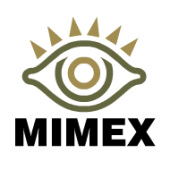 The
MIMEX project was a Data and Information
Fusion Defence Technology Centre (DIF DTC) cluster project comprising
two academic partners (Cardiff University
and the University of Southampton)
and one industrial partner (General
Dynamics UK Ltd). MIMEX aimed to investigate some of the key challenges
confronting military agencies in an era of effects-based operations and
network-enabled capabilities. These challenges include the need to integrate
information from physically disparate and semantically heterogeneous information
repositories, the need to coordinate response outcomes with bodies of socio-cultural
and psychological information, and the need to cope with hostile agencies
that may deliberately attempt to subvert or disrupt coalition decision making.
To address these challenges MIMEX focused on a solution strategy that embraced
semantic integration techniques, human factors analysis, trust evaluation
and cultural modelling. The operational focus area for MIMEX was Stability
and Support Operations (SASO), specifically Information Operations (IO).
IO forms part of a spectrum of military operations that entail the exploitation
of Open Source Intelligence (OSINT), often focused on the civil, rather
than the military, domain. Not only are these operations a central focus
of effects-based operations, they also reflect much of the operational reality
of current military engagements by British Armed Forces. While traditional
warfighting operations typically target effects against an enemy's ability
to fight, operations such as IO often attempt to achieve regional stability
by targeting the 'hearts and minds' of relevant social groups (i.e., those
groups with sufficient power and influence to instigate or control negative
events). This focuses attention on the need for enhanced cultural awareness,
which was a key aspect of the ontology engineering effort for MIMEX. The
aim was to develop ontologies that supported the ability of military coalition
forces to engage in culture-sensitive decision-making (i.e., decision-making
that was sensitive to the cultural idiosyncrasies of a specific area of
operations). This focus on cultural issues served as the basis for projects
such as the IEXTREME project, which attempted to combine
Web-based technologies with cultural modelling techniques in order to support
our awareness and understanding of culturally-disparate groups.
The
MIMEX project was a Data and Information
Fusion Defence Technology Centre (DIF DTC) cluster project comprising
two academic partners (Cardiff University
and the University of Southampton)
and one industrial partner (General
Dynamics UK Ltd). MIMEX aimed to investigate some of the key challenges
confronting military agencies in an era of effects-based operations and
network-enabled capabilities. These challenges include the need to integrate
information from physically disparate and semantically heterogeneous information
repositories, the need to coordinate response outcomes with bodies of socio-cultural
and psychological information, and the need to cope with hostile agencies
that may deliberately attempt to subvert or disrupt coalition decision making.
To address these challenges MIMEX focused on a solution strategy that embraced
semantic integration techniques, human factors analysis, trust evaluation
and cultural modelling. The operational focus area for MIMEX was Stability
and Support Operations (SASO), specifically Information Operations (IO).
IO forms part of a spectrum of military operations that entail the exploitation
of Open Source Intelligence (OSINT), often focused on the civil, rather
than the military, domain. Not only are these operations a central focus
of effects-based operations, they also reflect much of the operational reality
of current military engagements by British Armed Forces. While traditional
warfighting operations typically target effects against an enemy's ability
to fight, operations such as IO often attempt to achieve regional stability
by targeting the 'hearts and minds' of relevant social groups (i.e., those
groups with sufficient power and influence to instigate or control negative
events). This focuses attention on the need for enhanced cultural awareness,
which was a key aspect of the ontology engineering effort for MIMEX. The
aim was to develop ontologies that supported the ability of military coalition
forces to engage in culture-sensitive decision-making (i.e., decision-making
that was sensitive to the cultural idiosyncrasies of a specific area of
operations). This focus on cultural issues served as the basis for projects
such as the IEXTREME project, which attempted to combine
Web-based technologies with cultural modelling techniques in order to support
our awareness and understanding of culturally-disparate groups.
The MIMEX project was completed in March 2009. The project was a collaborative effort involving the University of Southampton, General Dynamics UK Ltd and Cardiff University.
AKTiveSA
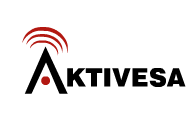 AKTiveSA
was a 3 year project that was undertaken as part of the UK's
Data and Information Fusion Defence
Technology Centre (DIF DTC) initiative. The principal aim of the AKTiveSA
project was to explore how advanced knowledge technologies could be used
to support enhanced situation awareness and inter-agency collaboration in
a specific operational context, namely humanitarian assistance and disaster
relief (HADR) operations. As highlighted by the MoD's
Joint Warfare Publication on Humanitarian/Disaster Relief Operations
(JWP 3-52), HADR operations often require military forces to inter-operate
with a variety of non-military agencies (e.g., NGOs, civilian government
agencies, UN organizations, and so on). Furthermore, HADR operations are,
by their very nature, typically undertaken in very hostile and dynamic information
environments, environments where relevant information is incomplete, uncertain
and liable to change. These features clearly pose a range of information
integration, exchange and interoperability challenges for military coalition
forces, and in order to deal with these challenges, the AKTiveSA project
explored a number of knowledge-based capabilities, each of which was built
on top of the Semantic Web.
AKTiveSA
was a 3 year project that was undertaken as part of the UK's
Data and Information Fusion Defence
Technology Centre (DIF DTC) initiative. The principal aim of the AKTiveSA
project was to explore how advanced knowledge technologies could be used
to support enhanced situation awareness and inter-agency collaboration in
a specific operational context, namely humanitarian assistance and disaster
relief (HADR) operations. As highlighted by the MoD's
Joint Warfare Publication on Humanitarian/Disaster Relief Operations
(JWP 3-52), HADR operations often require military forces to inter-operate
with a variety of non-military agencies (e.g., NGOs, civilian government
agencies, UN organizations, and so on). Furthermore, HADR operations are,
by their very nature, typically undertaken in very hostile and dynamic information
environments, environments where relevant information is incomplete, uncertain
and liable to change. These features clearly pose a range of information
integration, exchange and interoperability challenges for military coalition
forces, and in order to deal with these challenges, the AKTiveSA project
explored a number of knowledge-based capabilities, each of which was built
on top of the Semantic Web.
In addition to the focus on semantically-enabled capabilities, a significant proportion of the AKTiveSA project was devoted to an exploration of user interface design issues. This was reflected in the main technological outcome of the AKTiveSA project, namely the AKTiveSA Technical Demonstrator System (TDS). The AKTiveSA TDS is a Windows-based desktop application that combines a 3-D information visualization environment with a variety of graphical components to support the adaptive retrieval, manipulation and visualization of operationally-relevant information. The following narrated videos provide a brief overview of the functionality of the AKTiveSA TDS (simply click on a thumbnail image to access the video). Alternatively, some screenshots of the AKTiveSA TDS are available here.
The scientific and technological outcomes of the AKTiveSA project provided the basis for a number of subsequent research projects. These included the SEMIOTIKS project (which focused on information extraction, knowledge processing and information visualization) and the MIMEX project (which focused on issues of cognitive augmentation, trust and the sharing of information across organizational and cultural boundaries).
The AKTiveSA project was completed in December 2006. It was undertaken as a stand-alone project as part of the UK's Data and Information Fusion Defence Technology Centre (DIF DTC) initiative.

